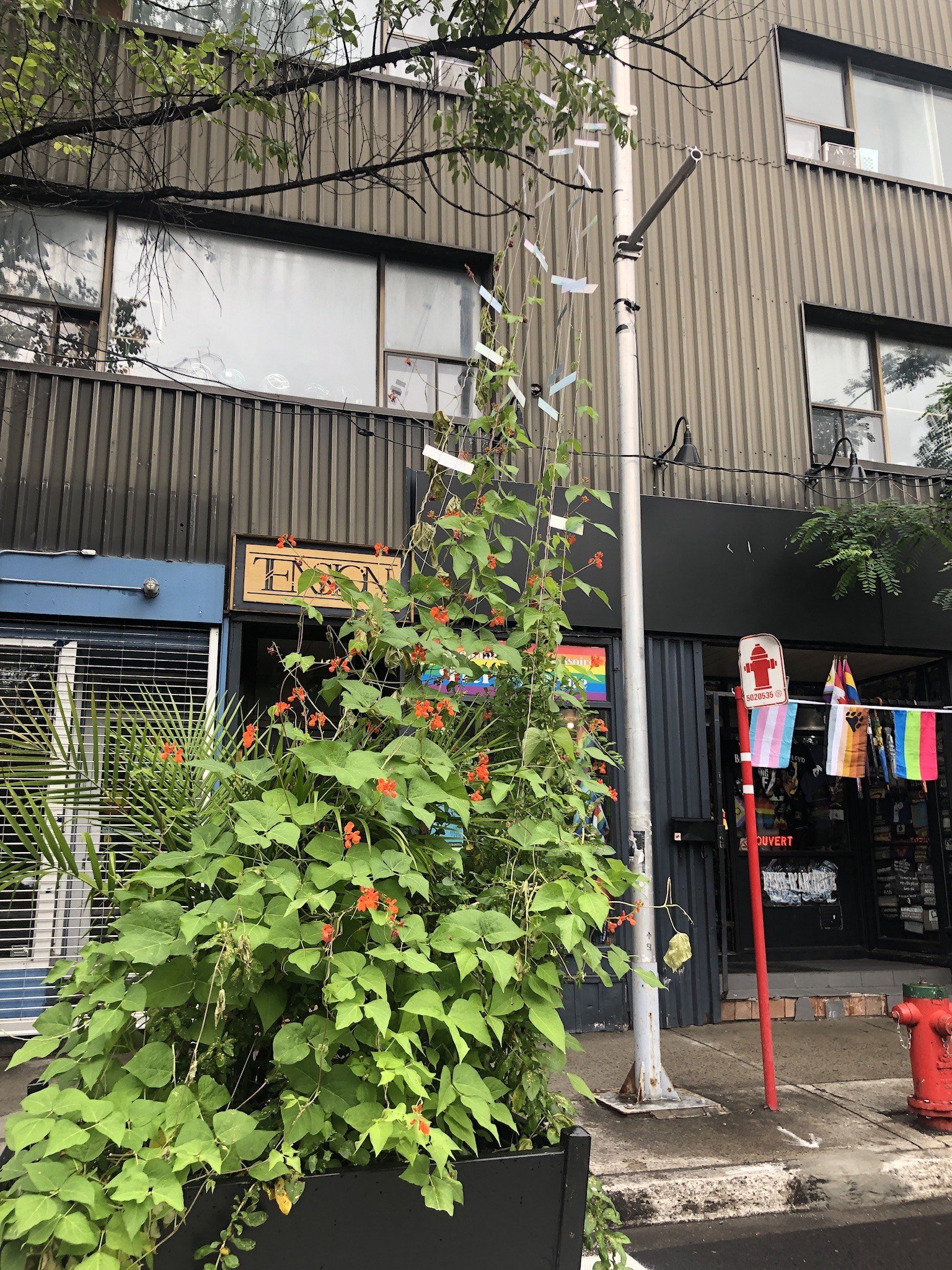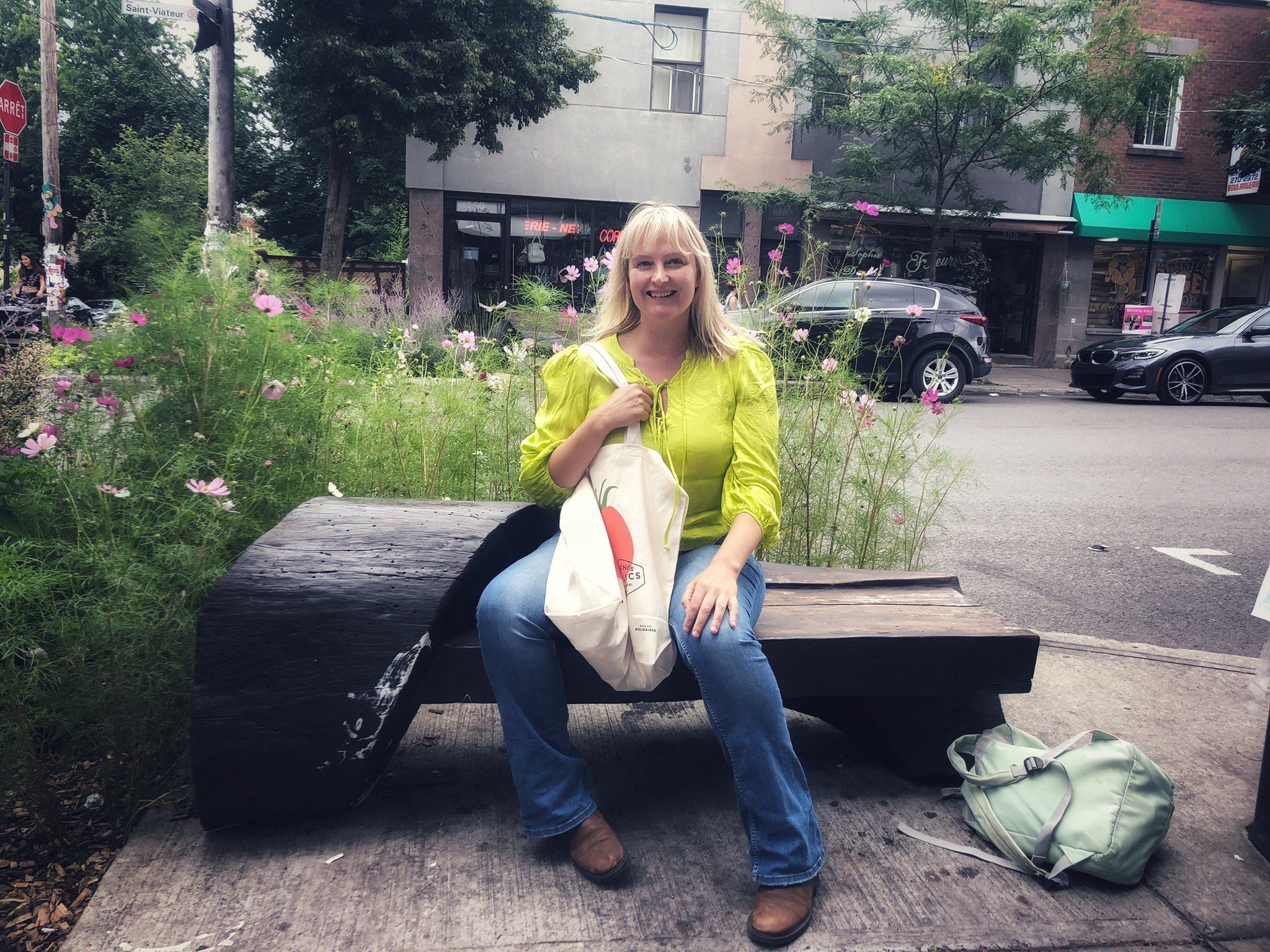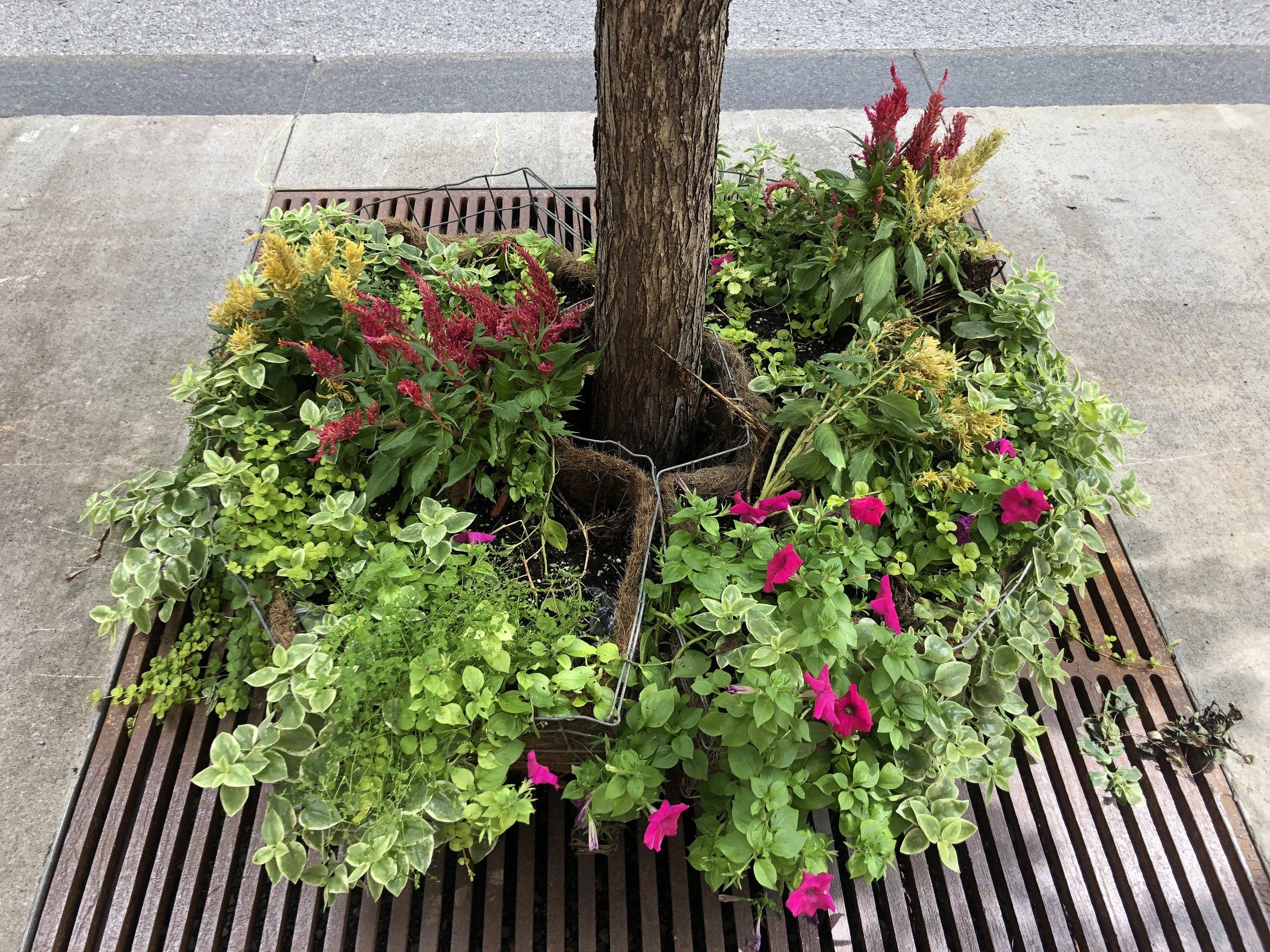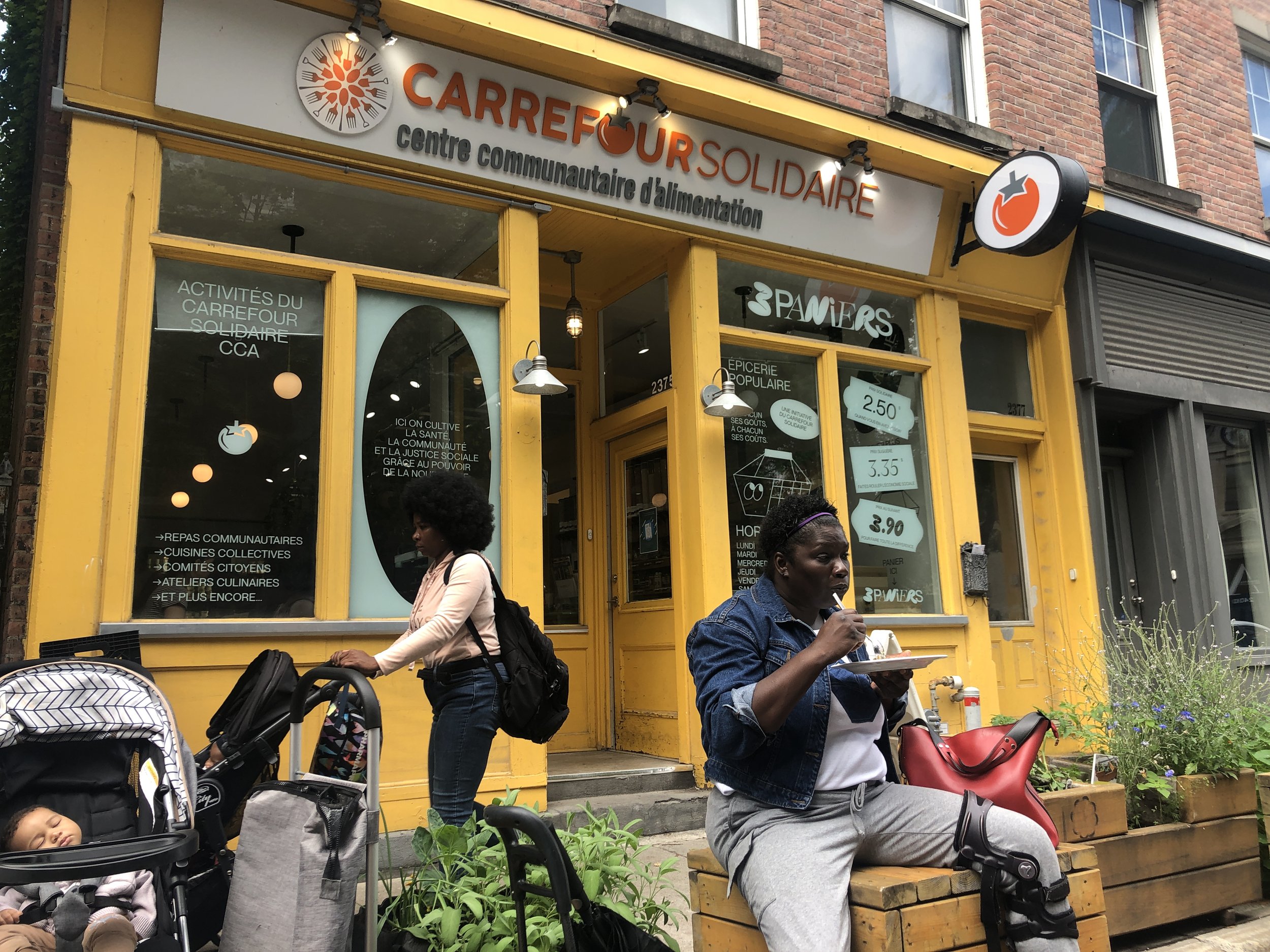So green Montréal…
A scarlet runner growing upwards attached to a lamppost on pedestrianised Rue Sainte-Catherine East
Not only is Montréal home to the late and great Leonard Cohen, but it lays claim to having the largest commercial urban roof top farm in the world. In 2022, Mayor Valerie Plante (nominative determinism strikes again!) pledged to make it the ‘greenest city in North America.’
At a fleeting glance, on a hot and humid day in August, it is clear that Montréal places great importance on its public realm. It was a joy to see the wide variety of green interventions on nearly every street, no matter how large or small: great thought and imagination has gone into creating a city for people and wildlife.
Belles idées
Some of my favourite public planting around the city included:
The abundant planting and tree trunk benches in the ultra-cool Whitechapel area of the city. Each area is carefully planted and cared for. Residents use every space and even grow climbers up their staircases.
Abundant street planting in Whitechapel
In the Quartier des Spectacles, a long pedestrianised street in the centre of the city is home to some original environmental art including revolving trees created by the artist Robert Hengeveld, aptly named Revolution – his work explores the relationship between the natural world within the context of the manufactured landscape. The Esplanade Tranquille in the same area is great space to relax and rest.
Many of tree bases in the city have been lovingly planted up with imaginative planting
A wilder vision
I was in Montréal to meet people and organisations leading the way in urban agriculture, as part of my Churchill Fellowship, but was happily distracted by the abundant planting around the city. I am co-founder and director of Wilder, a social enterprise based in London that is creating spaces for wildlife in city. As part of my Fellowship I will be travelling overland across cities in Canada and the US to identify best practices in sustainable food production, particularly in ensuring that urban food farming increases biodiversity and the role of civil society in urban farming.
Food for all the community
I had the pleasure of starting my trip at Carrefour Solidaire, an organisation that ‘cultivates a healthy community and social justice through the power of food.’ I met one of the directors, Beccah Frasier, who showed me some of their creative community projects. Our first stop was the pristine and biodiverse roof space that was created together with Prevale and Laboratoire sur l'agriculture urbaine (AU/LAB): the space is managed by garden coordinators who work with the community, and all the food harvested goes back into the community.
Our next stop was ‘the largest edible pedestrian street in Canada’. It was set up in 2022 in the Ste-Marie district of the city. The street was full of a variety of vegetables growing in fabric ‘smart pots’. These pots hold a soil depth of 20cm which is enough to support a good yield of almost every vegetable and herb. This is the first time I have come across smart pots: their benefits include good aeration, water drainage and heat release. Since the street opened they have grown more than 500kg of vegetables and fruits which have been distributed to the community
I finished my tour in the very stylish Carrefour Solidaire, 2375 Rue Sainte-Catherine East, a community kitchen and shop where we enjoyed a meal of borch, potato salad and pancakes, all made by the guest Russian chef: there was even a recipe that you could take away. People who shop at Carrefore Solidare can pay three different prices depending on their circumstances; after analysing their takings over a period of time the amount of money they make even outs over time, with a third of people paying the lower price, a third paying the market price and a third paying the higher price. I spent some time people-watching in their cute little outside space at the front of the cafe, and it was clear that there was a real mix of people from all backgrounds and ages coming together to use the space: something I rarely see in London.
New wave farming
My next visit took me to Lufa Farm in the District Centrale: it is an industrial estate about 6km from the centre of Montréal. Lufa Farms was founded in 2009 by Mohamed Hage and his wife Lauren Rathmell – their ambition was the reinvent the food system. Since then, they have set up four farms around the city, the last one being pegged as the world’s largest commercial urban rooftop farm. It spans 160,000 square feet (the size of three football fields) and grows around 20,000 greens at any one time. Unfortunately, this site is closed to the public as it has to maintain a controlled environment.
I met Emily, Lufa’s comms manager, who showed me around their first commercial farm on Rue Antonio-Barbea. With just 300 square feet growing space, it is relatively modest in size compared to their newest site. Donning a plastic lab coat and wellies I got to see hydroponics in action –they use peat moss and coconut husk to grow micro greens: fruits and water rather than soil is used to provide nutrition.
Lufa sell directly to consumers and work with smaller farmers around the Montréal area. The green roof I visited has two temperature zones and is primarily heated by residual heat from the building below. It is a very interesting concept and is able to provide food all year round, plus it reduces air miles and puts less pressure on the surrounding countryside.
Inside the lufa farm on Rue Antonio-Barbea
Hydroponically grown chives
Cooperation is central
The next day I returned to District Centrale to visit La Centrale Agricole, the largest urban agriculture Coop in Quebec, which hosts 21 companies, mainly start-ups working in the urban agricultural space. They offer affordable space, and have shared common areas like kitchens, warehouses and cold rooms. It is a place for networking and innovation for the development of urban food systems and the circular economy, and the shared spaces facilitate new ideas and connections.
I was kindly shown around by LN Saint-Jacques, the Director of La Centrale Agricole, who is very keen on helping organisations develop and grow. Any profit made is is reinvested into back into the cooperative which helps further support organisations in the building.
The building has both a large indoor space and a large roof space where they have one of the biggest rooftop vineyards in the world. Vignes en Ville is also located in the building and is project studying the behaviour and advantages of hardy vines in urban areas, both in the ground and in containers on roofs.
I met Guillaume Laliberté who co-founded Lieux Communs wines, Montréal’s first urban winery: they make wine, cider and piquettes. The model was taken from the west coast of America, where land prices are super high so it’s impossible to buy land. Lieux Communs rent a piece of land where they grow wine (they have 25-year agreement), and they also source a variety of fruits from Quebec and Ontario. They use leftover grape skin to make piquettes, a light beverage (around 4% alcohol) that is very popular amongst young people in Montréal, who spend a lot time in the beautiful parks during the summer months.
Guillaume Laliberté from Lieux Communs
Better than fiction
On the bus on my way to a meeting with AULab President Eric Duchemin I randomly got chatting to a woman dressed up and heading to Montréal’s annual manga convention: coincidentally she works for the mayor as an urban planner and she kindly pointed me in the direction of the city’s ambitious climate action plan. In 2022, when Montréal hosted the UN Biodiversity Conference: COP15, Mayor Valerie Plante pledged to:
Increase the percentage of protected land to ten per cent of Montréal’s territory by 2030, up from the current eight per cent
Create five ‘ecological corridor projects’ to connect green spaces to one another, which will allow pollinators to pass between them more freely
Revise nineteen bylaws on cleanliness and nuisances to allow for landscaping that is favourable to pollinators
Improve the conditions of pollinator habitats, specifically by reducing the frequency of mowing and other types of maintenance work.
In terms of urban agriculture, the city has a clear strategy:
Educate people and raise awareness about urban agriculture, and encourage its practice by residents and communities
Increase agricultural production within Montréal city limits and support commercial urban agriculture
Encourage resilient and ecological urban agriculture
Improve the management and governance framework for urban agriculture.
When I finally reached the convention centre it was easy to spot Eric Duchemin – president of AU/LAB, an environmental scientist and now a world leader in urban agriculture – as he wasn’t wearing an elaborate manga costume. AU/LAB is a non-profit and encourages the emergence of initiatives relating to the production, processing, distribution and marketing of urban agriculture. The ultimate aim is to develop a fully sustainable food system and a circular economy. Since it was set up in 2009, its team has been supporting and encouraging innovation in urban agriculture by working with many organisations around the city.
We went from the hustle and bustle of downtown Montréal to the green roof space (Urban Agriculture Laboratory) Palais des Congrès de Montréal. The aim of the space is to help reduce urban heat island effect and improve air quality, and encourage industry and property owners to green their rooftops. The space currently serves multiple purposes, including as a growing area used by refugees: it offers some respite from the settling in phase, and the opportunity to grow their home vegetables. There are vines growing grapes that will be turned into wine, and a wildflower bed brimming with life which is open all hours for the local honeybees.
La fin
From the vibrant pink impatiens (touch-me-nots) beautifully adorning Leonard's Cohen’s grave to the wide variety of public planting and innovative green roof projects, Montréal is a deep green city. We can learn a lot from the people and organisations working to make it an even better place to live and work.













